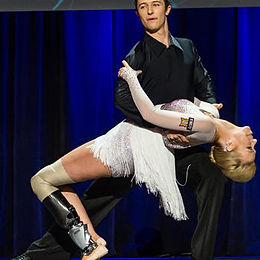Welcome to ProstheKicks!
Social, Motivational Dance Course for Amputees
Dance's Affect On Amputees
Dance has already proven to be a therapeutic tool to help strengthen the minds and bodies of persons with a disability. Dance/movement therapy is the therapeutic use of movement to further the emotional, cognitive, physical and social integration of the individual, based on the empirically supported premise that the body, mind and spirit are interconnected.
Dance is the best combination of physical and mental therapy because in addition to being a physical exercise it activates muscles in the brain that results in a happier person. Join The Movement.

Alissa Sizemore

"I just didn't want to give up," Alissa tells PEOPLE. "Dancing has been my favorite thing since I was 4. I don't have part of my leg, but I can't let that stop me. I still want to dance."
Alissa Sizemore was 7 years old when she ran into the path of a UPS truck in May 2014. Her right foot was crushed under one of the delivery truck's tires and had to be amputated.
Before being fitted with a prosthetic, Alissa heard the Colbie Caillat ballad "Try." The song, with lyrics that emphasize finding beauty in oneself despite physical imperfections, resonated with Alissa."It's a song that I found when my mom and dad first saw me dancing without my leg," said Alissa, who decided to dance her first solo at Powerhouse Dance Studio's recital ."I went to the dance teachers and I said, 'I want (the solo routine) to be her,'" Heather Sizemore (mother of Alissa) said. "Show her — with or without the leg — she can still dance.
Alissa continues to follow her passion and dances to this day.

Adrianne Haslet-Davis

For Adrianne, her philosophy about dancing is best captured in a comment she often makes: "Dancing is the only thing that, when I do it, I don't feel as though I should be doing anything else."
Adrianne Haslet-Davis has survived the unimaginable bombings at the 2013 Boston Marathon, where she lost her left leg below the knee.
She is quickly rising to meet her daily challenges head on with a unique perspective. Being a ballroom dancer and former Fortune 500 corporate manager, at the peak of her career, she has had to re-learn her craft and an entirely new meaning to the word patience.
In the wake of the marathon, she has become an inspiration through her positive attitude and infectious smile.
"I refuse to be called a victim. I am not defined by what happened in my life. I am a survivor, defined by how I live my life." - Adrianne

Gabi Shull

Cancer fighter Gabi Shull had her leg amputated she feared that she would never dance again. Now, with her prosthesis she can dance on pointe.
